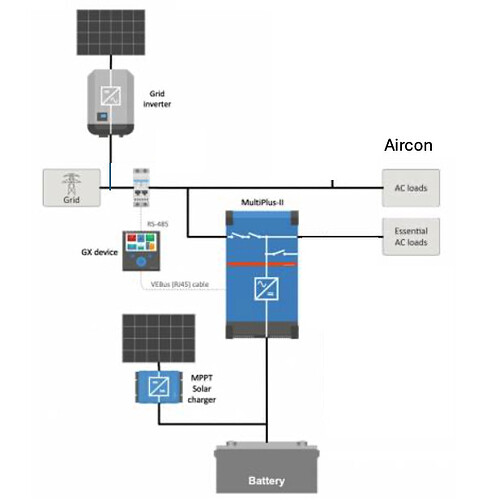Hi Dave,
thanks for the response. Yes, good thinking, but realistically I’m not allowed to mess around with my already installed grid-connected PV installation & that is a 3 phase system.
I also don’t see how this would solve my challenge with limiting battery charging if/when the system is AC connected.
For clarity. System normally would work in an off-grid mode. Using 2x2kw in solar panels, 10KW of batteries. But there will be times that either the load is too high (short periods when air-conditioning starts up in summer) or batteries are low. At this time, I like to switch the inverter to AC. (conditional AC input connection, based on load and SoC / Voltage)
But - what I like to prevent is that at those moments, AC is being used to charge the batteries.
While in day time that might be fine (as I’m also exporting to the grid from my other system) - At night it would mean I charge from AC & Importing energy.
IF the inverter is connected to AC - then changing the current limit for AC input won’t be a good idea, I will need that to run the Air-conditioner. I could change the max charge current, but since that’s for AC + PV, it means that PV goes to waste (if there is)
I’m thinking for this use case, I might need to get a Multi Plus II GX, with two Smart Solar Charge Controllers. These smart controllers will charge batteries from Solar, regardless what the inverter does. And I can set the inverter connect AC once load is high or batteries are low; with a low or zero charge current. This will stay then that way, until the load drops or batteries are recharged (by solar).
The challenge is that the Multi Plus II GX 5000 model has a lower max power output, the next model up (MultiPlus II 8000) is almost twice the cost and I need to get the Cerbo separate and still ned to add the two Solar Charge controllers. The RS Smart (without solar) and two solar charge controllers, which would allow me to do the same as the Multi Plus II GX example above, is again a fair bit more expensive.
–
What happens if you set the max charge current set to 0, and there is more PV in than being used by the loads? (not AC connected, not ESS) ? I guess the energy won’t be used correct ?
Cheers,
y.
